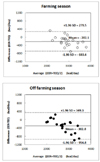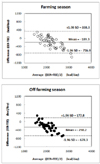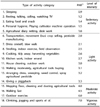1. Ministry of Health and Welfare, Korea Centers for Disease Control and Prevention. Korea Health Statistics 2011: Korea National Health and Nutrition Examination Survey (KNHANES V-2). Cheongwon: Korea Centers for Disease Control and Prevention;2012.
2. Health Assistant for Obesity Management. Seoul: Hanmi Medical Publishing Co.;2003.
3. Lee JA, Kong KH, Ko HY, Bae KH, Park SY, Park KM, Song YK, Park JH, Kim HJ, Park SJ, Park JS, Ko SG. Recent topics of clinical trials in obesity and metabolic study. J Soc Korean Med Obes Res. 2009; 9:15–22.
4. Kim HN, Jun SG, Jung HR, Lee DS. The energy expenditure of female farmer. Survey Improvement Nutrition of Farming. Seoul: Rural Development Administration;1986. p. 133–151.
5. Lim WJ, Yoon JS. A longitudinal study on seasonal variations of physical activity and body composition of rural women. Korean J Nutr. 1995; 28:893–903.
6. Lee KY, Cho HK, Kim OS, Lee YS, Lee SM, Hong DS, Cho HS, Kim YK, Kim JH. An analysis of rural families' time-use. J Korean Home Manage Assoc. 2006; 24:205–222.
7. Choi JW, Hwang KS. The adaptability of Korean farmers to environment by the seasonal fluctuation of energy expenditure, cold and heat tolerance. Korean J Community Living Sci. 2006; 17:49–60.
8. World Health Organization (CH). World Health Organization Technical Report Series 724: Energy and Protein Requirements. Report of a Joint FAO/WHO/UNU Expert Consultation. Geneva: World Health Organization;1985.
9. Park J, Kazuko IT, Kim E, Kim J, Yoon J. Estimating free-living human energy expenditure: practical aspects of the doubly labeled water method and its applications. Nutr Res Pract. 2014; 8:241–248.

10. Kim EK, Lee SH, Ko SY, Yeon SE, Choe JS. Assessment of physical activity level of Korean farmers to establish estimated energy requirements during busy farming season. Korean J Community Nutr. 2011; 16:751–761.

11. Weir JB. New methods for calculating metabolic rate with special reference to protein metabolism. J Physiol. 1949; 109:1–9.

12. Ministry of Health, Labour and Welfare (JP). The Fifth Japanese Dietary Allowance. Tokyo: Ministry of Health, Labour and Welfare;1985.
13. Rural Development Administration, Research and Training Institute Rural Nutrition Improvement. Energy Metabolism in Different Activities. Suwon: Research and Training Institute Rural Nutrition Improvement;1994.
14. The Korean Nutrition Society. Dietary Reference Intakes for Koreans. Seoul: The Korean Nutrition Society;2010.
15. World Health Organization (CH). WHO Technical Report Series 894: Obesity: Preventing and Managing the Global Epidemic. Report of a WHO consultation. Geneva: World Health Organization;2000.
16. Schultink WJ, Klaver W, Van Wijk H, Van Raaij JM, Hautvast JG. Body weight changes and basal metabolic rates of rural Beninese women during seasons with different energy intakes. Eur J Clin Nutr. 1990; 44:Suppl 1. 31–40.
17. Bleiberg FM, Brun TA, Goihman S, Gouba E. Duration of activities and energy expenditure of female farmers in dry and rainy seasons in Upper-Volta. Br J Nutr. 1980; 43:71–82.

18. Ministry of Health and Welfare (KR). A Study to Determine the Recommended Dietary Allowance of Energy and to Develop Practical Dietary Education Program for Korean Adults. Gwacheon: Ministry of Health and Welfare;2002.
19. Park JA, Kim KJ, Yoon JS. A comparison of energy intake and energy expenditure in normal-weight and over-weight Korean adults. Korean J Community Nutr. 2004; 9:285–291.
20. Lee JS, Lee GH, Kim EK. Assessment of daily steps, activity coefficient and daily energy expenditures of dieticians in the Youngdong-area. J Korean Diet Assoc. 2006; 12:277–288.
21. Durnin JV, Drummond S, Satyanarayana K. A collaborative EEC study on seasonality and marginal nutrition: the Glasgow Hyderabad (S. India) Study. Eur J Clin Nutr. 1990; 44:Suppl 1. 19–29.
22. Westerterp KR, Meijer GA, Janssen EM, Saris WH, Ten Hoor F. Long-term effect of physical activity on energy balance and body composition. Br J Nutr. 1992; 68:21–30.

23. Seong BJ, Kim CK. The effects of swimming exercise on body composition and hormone of obese adolescents. Exerc Sci. 1999; 8:447–459.
24. Kim CK, Sung BJ. The effects of aerobic exercise on the serum leptin in young obese subjects. J Sports Sci Res. 1999; 18:61–71.
25. Kim YM, Quan ZY, Kim MK, Choi BY. Trends in obesity in rural Korean adults (1990~1999). J Agric Med Community Health. 2005; 30:113–120.
26. Rennie DW, Covino BG, Blair MR, Rodahl K. Physical regulation of temperature in Eskimos. J Appl Physiol. 1962; 17:326–332.

27. Rabinowitch IM, Smith FC. Metabolic studies of Eskimo in the Canadian eastern aretic. J Nutr. 1963; 12:337–356.
28. Yoshimura M, Yukiyoshi K, Yoshioka T, Takeda H. Climatic adaptation of basal metabolism. Fed Proc. 1966; 25:1169–1176.
29. Fujimoto S, Watanabe T. Seasonal variation of energy metabolism. Acta Med Nagasaki. 1965; 10:1–11.
30. Nakamura M, Hori S, Sugawara K, Tsuchimoto M, Ihzuka H, Sugawara M, Nohara H, Kuwano K. Basal metabolism and serum protein bound iodine and characteristics of their seasonal variations in Okinawa-inhabitants. Jpn J Biometeorol. 1980; 17:78–86.
31. Hwang KS, Choi JW. Effect of occupational cold exposure on the human cold-resistance. J Korean Home Econ Assoc. 1997; 35:53.
32. Lee KY, Chee SH, Hong SK, Sung YH. Seasonal variations in the basal metabolic rate of Korean airmen volunteers. Korean J Physiol. 1972; 6:95–102.
33. Frankenfield D, Roth-Yousey L, Compher C. Comparison of predictive equations for resting metabolic rate in healthy nonobese and obese adults: a systematic review. J Am Diet Assoc. 2005; 105:775–789.






 PDF
PDF ePub
ePub Citation
Citation Print
Print












 XML Download
XML Download